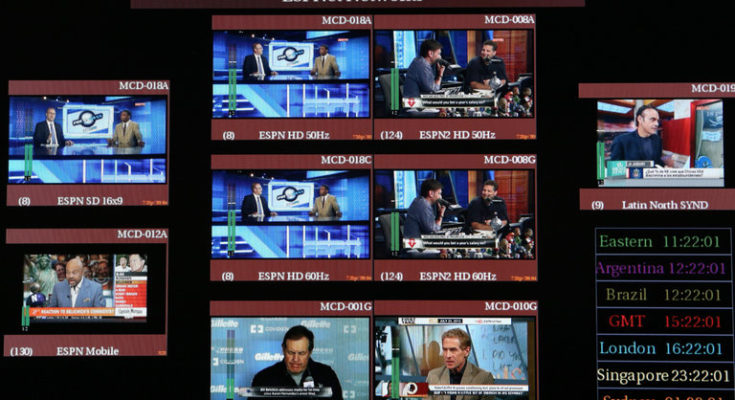The “Worldwide Leader in Sports,” as ESPN brands itself, laid off scores of journalists and on-air talent on Wednesday, showing that even the most formidable media kingdom was vulnerable to the transformation upending the sports broadcasting industry as more and more people turn away from cable television.
Among the prominent people let go were the former N.F.L. players Trent Dilfer and Danny Kanell, the former N.B.A. player Len Elmore, the former baseball general manager Jim Bowden and the longtime N.F.L. reporter Ed Werder.
ESPN is by far the biggest and most powerful entity in the sports media industry, and it has felt the sting as viewers turn away from traditional ways of consuming live sports.
The network has lost more than 10 million subscribers over the past several years. At the same time, the cost of broadcasting major sports has continued to rise. ESPN committed to an eight-year, $15.2 billion deal extension with the N.F.L. in 2011; a nine-year, $12 billion deal with the N.B.A.; and a $7.3 billion deal for the college football playoffs, among many others.
“ESPN was wrapped in Teflon for many years, but big payouts for rights fees plus significant losses in their subscriber base were like punches to the gut and head, and now the company is trying to make sure they are strong enough to fight in the future,” said James Andrew Miller, who wrote a book on ESPN and has contributed to The New York Times. “They’ve decided one way to do this is to change their approach to content and rely more heavily on digital; this has enabled them to let go of a big chunk of their talent base.”
In October 2015, ESPN laid off about 300 people, most of whom were not on camera. The network has been periodically culling its staff as it searches for ways to cut costs and adapts to changing consumer habits, with fans increasingly watching video clips on their smartphones at the expense of traditional highlight shows like “SportsCenter.” With ESPN locked into long-term contracts for programming rights with various sports leagues, savings must primarily come from a reduced staff.
In a letter to employees on Wednesday, ESPN’s president, John Skipper, acknowledged the “difficult decisions” ahead and suggested what the network was looking for as it reshapes itself.
“Dynamic change demands an increased focus on versatility and value, and as a result, we have been engaged in the challenging process of determining the talent — anchors, analysts, reporters, writers and those who handle play-by-play — necessary to meet those demands,” Mr. Skipper said in the statement.
In the most recent quarter, Disney’s cable networks division reported $864 million in operating income, an 11 percent drop from the same period a year ago, with ESPN the reason for the entire decline, Disney said at the time. The company blamed higher N.B.A. and N.F.L. programming costs and lower ad sales for the weak results.
Earlier this month, Amazon paid $50 million for streaming rights to 10 of the N.F.L.’s Thursday night games for the 2017 season — or five times more than what Twitter paid a season ago, according to SportsBusiness Journal, which also reported that Facebook and YouTube bid on the package.
The ESPN layoffs come as Disney accelerates efforts to introduce an ESPN-branded subscription streaming service. The offering, expected this year and made possible by Disney’s $1 billion purchase in 2016 of part of BamTech, Major League Baseball’s streaming division, will include coverage of sports like hockey, tennis, cricket and college sports — mostly rights that are owned by ESPN, but not televised.
“You have to be willing to either create or experience some distribution as we migrate from what has been a more traditionally distributed world to a more nontraditional distribution world,” Robert A. Iger, Disney’s chief executive, told analysts on a conference call in February. “And some of that we’re going to end up doing to ourselves, meaning that we understand there is disruption, but we believe we have to be a disrupter, too.”

Disney has long relied on ESPN’s steadily climbing cable subscriber fees as a profit engine. But cable networks across the board have been losing viewers to online media, which has slowed growth, and Wall Street has responded unfavorably.
Despite assurances by Mr. Iger that ESPN remains strong, investors and analysts have remained concerned about upheaval in the television business. Viewership via satellite and cable services is declining as streaming options proliferate, and ESPN, the naysayers contend, is particularly exposed to a slowdown because Disney has locked itself into lavish, long-term payments for sports rights.
In a sign that Disney had done a good job preparing investors for the layoffs, shares climbed slightly in Wednesday morning trading. (By JOE DRAPE and BROOKS BARNES)
John Skipper has just sent memo to all @espn employees. Layoffs announced today. Around 50 names you will recognize; another 50 you may not.
— jamesmiller (@JimMiller) April 26, 2017
Here are some of the ESPN employees who have made statements on social media so far (we will update this list):
Jay Crawford, “SportsCenter” anchor
After 14 wonderful years my time at espn is over. From Cold Pizza to First Take to SC I made more friends than I can name. Forever grateful! pic.twitter.com/WNkUGuXeVl
— Jay Crawford (@jaycrawfordespn) April 26, 2017
Ed Werder, N.F.L. reporter
After 17 years reporting on #NFL, I’ve been informed that I’m being laid off by ESPN effective immediately. I have no plans to retire
— Ed Werder (@Edwerderespn) April 26, 2017
Jayson Stark, baseball writer
For 17 yrs I’ve had a dream job covering baseball for ESPN. Today is my last day. Thanks to all the great people at ESPN, MLB & all of you!
— Jayson Stark (@jaysonst) April 26, 2017
Dana O’Neil, college basketball reporter
Add me to the list. Just got the ‘call.’ I’ve been informed my contract will not be renewed at ESPN.
— Dana O’Neil (@ESPNDanaOneil) April 26, 2017









